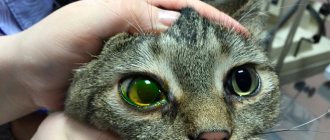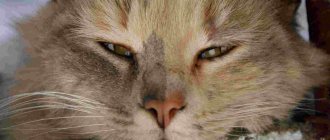Causes of the disease
People call conjunctivitis “sourness” of the eyes. This pathology among pets is not uncommon and cannot be ignored, as it can have serious consequences for the health of animals. The basis of treatment is the elimination of the factor that provoked inflammation of the mucous membrane.
Among the causes of conjunctivitis, the most common are the following:
- bacteria, parasitic and fungal infections, viruses, staphylococci;
- allergies to food, detergents, pollen, etc.;
- mechanical damage to the organ of vision;
- irradiation;
- foreign bodies in the eyes;
- parasite infection;
- weakened immunity;
- cold;
- poisoning by chemical vapors.
Conjunctivitis is more often diagnosed in kittens, but this does not mean that adult animals are not susceptible to this pathology. The disease can occur in any cat, regardless of age and breed.
If you do not pay attention to inflammation of the conjunctiva, the disease can take a chronic form, which, in turn, can lead to decreased vision.
Forms of conjunctivitis
Another type of conjunctivitis is viral, which is caused by fungal or bacterial pathogens.
Conjunctivitis is a viral disease characterized by the development of an inflammatory process on the mucous membrane of the fundus of the eye. In cats it comes in several types:
- Catarrhal. It is a mild form, but in the absence of appropriate therapy it quickly develops into a complex form. It causes profuse lacrimation and swelling of the eyelids. As a result, the fur around the eyes is constantly damp. There is a possibility of an increase in body temperature.
- Purulent. Moderate severity. One or both eyes are affected. Accompanied by large amounts of purulent discharge from the eye sockets, which sometimes leads to sticking of the eyelids. Drying pus forms crusts along the eyelids. The clinical picture is the same as for the catarrhal variety of the disease.
- Phlegmonous. The most severe form, in which purulent masses accumulate under the layer of the conjunctiva and partially penetrate the eyeball. This leads to damage to the third eyelid with subsequent protrusion outward. Emergency veterinary intervention, including surgery, is required.
- Chlamydial. It is most often transmitted from an infected mother or during childbirth and appears at an early age (in kittens). Regardless of the stage of the disease, there is a danger of loss of vision for animals. To avoid harmful consequences, emergency and proper treatment is necessary.
Main symptoms
It is easy to identify conjunctivitis in a cat. The animal experiences increased lacrimation, causing it considerable discomfort. The pet constantly squints, avoids bright sunlight, and washes itself, trying to clean its eyes.
In this case, you can see that the cornea is covered with a cloudy film, the eyelids are swollen, and the eyes are red. Discharges of various types - from clear to purulent, depending on the form of conjunctivitis. In the morning the eyelids are glued together.
Prevention
To prevent conjunctivitis in a cat, you need to:
- feed the animal with balanced food;
- regularly carry out deworming, vaccination and vitamin courses;
- prevent fights with other pets, contact with homeless and wild animals;
- promptly treat viral diseases;
- regularly carry out wet cleaning of the house or apartment, clean the cat litter immediately after contamination;
- store caustic chemicals (solvents, household chemicals, etc.) out of reach of the cat and prevent close contact with perfumes, cosmetics and UV lamps;
- monitor the condition and well-being of the animal.
Diagnostics in a veterinary clinic
Diagnosis in a veterinary clinic is aimed at identifying the cause of conjunctivitis. In addition to a visual examination and medical history, the veterinarian conducts a number of diagnostic tests to differentiate inflammation of the conjunctiva from other diseases of the organ of vision.
Necessary diagnostic measures include taking samples of discharge from the conjunctiva and a biochemical blood test.
Determining the nature of discharge from the eyes is of great importance. So, purulent means the development of a bacterial infection, mucous means an allergic reaction, serous means a virus that has developed in the body.
Reaction to chemicals
A cat can also get conjunctivitis through contact with aggressive chemicals. However, the chemical does not necessarily have to get into her eyes. Inflammation can develop even with careful sniffing of household products or other strong-smelling substances.
Burns to the mucous membrane are extremely dangerous, so you need to help your cat as soon as possible. If the inflammation has become alarming, take your cat to the vet immediately.
Treatment method and prognosis
There is no single treatment regimen for conjunctivitis. Therapy depends on the type of disease and is complex. In this case, not one eye should be treated, but both.
Drug therapy includes washing the conjunctival organ, using antibiotics, corticosteroids, painkillers, special drops and ointments that relieve inflammation.
Eye rinsing is a mandatory procedure that is performed before each application of ointment or use of drops. Diamond Tear drops, which contain taurine, succinic acid, and chlorhexidine, have proven themselves well.
After washing, special ointments are used. The drug is applied not with your fingers, but with a glass rod, which is first doused with boiling water. An ointment the size of a match head is applied under the eyelid twice a day.
Cats tend to experience resistance, so you can apply a little ointment to the lower eyelid and wait for the animal to blink properly. Thus, the drug will be evenly distributed in the desired area.
Effective antibiotic ointments for conjunctivitis:
- Tetracycline;
- Erythromycin;
- Levomycetinic;
- Sofradex;
- Misofen;
- Optimmune.
Many pet owners believe that drops are much more convenient to use, as they are well distributed throughout the mucous membrane. However, this form of the drug has a drawback: discharge from the eyes. An ointment with a denser structure undoubtedly has a better effect.
The course and dosage is determined by the doctor depending on the stage and form of the disease.
As a rule, the specialist prescribes:
- Dexamethasone;
- Leopard;
- Iris;
- Conjunctivitis;
- Lacrican;
- Lacrimin aseptic;
- Tsiprovet;
- Dekta;
- Barrier.
Important: cats are not allowed to put Albucid (sodium sulfacyl) human drops into their eyes. They can cause severe irritation and burns to the cornea! Of the drugs intended for humans, the use of Tsiprolet, Floxal, Levofloxacin drops is allowed.
For chlamydial conjunctivitis, Ciprovet is used, which is administered intramuscularly.
The purulent form of the disease usually occurs either due to allergies or helminthic infestation. In such cases, a course of antihistamines or treatment for parasites is necessary, respectively. If conjunctivitis is of infectious origin, treatment is aimed at eliminating the pathogen with antibiotics.
In case of complications and damage to the eyeball, the use of novocaine is necessary.
What is conjunctivitis in cats - how it manifests itself and why it is dangerous
The conjunctiva is the inner mucous membrane of the eye, protecting it from drying out and damage. The inflammatory process that affects it is called conjunctivitis. If your pet often rubs his eyes, which are constantly watering, and mucous or purulent discharge accumulates in the corners of the eye socket, it’s time to visit the veterinarian.
The inflammatory disease has a variety of forms and varieties. Pathological changes in the mucous membrane, on the one hand, may be a consequence of exposure to external irritants, and on the other, the state of the conjunctiva may be a reflection of a developing infectious process, a disease of one of the internal organs, or a malfunction in the metabolic process.
The intensity of manifestations depends on the form of the disease, which can be acute, subacute and chronic. The first form is characterized by the sudden onset of characteristic symptoms and their severity. The subacute form is slightly weaker than the acute form, while the chronic form is characterized by slow development and mild symptoms.
Common symptoms of conjunctivitis in felines are:
- redness of the mucous membrane of the eye;
- swelling of the eyelids;
- profuse lacrimation and the presence of mucous or purulent discharge;
- frequent attempts by the animal to “wash” its eyes;
- sticking of the eyes after sleep;
- constant blinking and squinting of the eyes, fear of light.
Common symptoms of any form of inflammation of the conjunctiva are excessive lacrimation and redness of the mucous membrane
You should know that conjunctivitis is a rather dangerous disease - if not treated promptly or incorrectly, the animal may lose its vision. This pathology is contagious - both to other animals and to humans. Therefore, when interacting with a pet, you must follow basic hygiene rules, and treatment must be carried out with gloves.
What to do at home
The owner must create the most comfortable living conditions for the sick pet and strictly follow the veterinarian’s instructions. Under no circumstances should you self-medicate, as it can aggravate the situation.
Some traditional methods can be used for conjunctivitis, but they should not replace conservative treatment. It is acceptable to use them in combination with medications.
Most often, at home, a decoction of chamomile and calendula is used to wash the eyes. You need to take 1 teaspoon of dried plants, pour boiling water, cool and let it brew. You need to wipe your eyes with a disinfectant decoction at room temperature 2-5 times a day. Black tea has a similar effect.
Instillation of willow decoction has a good effect. Willow is a natural antibiotic. To obtain a medicinal infusion, take 2 tablespoons of dried and crushed twigs, pour a glass of hot water, and boil for 5 minutes. Then cool and insist. To relieve inflammation and eliminate germs, you should bury or wipe your eyes 3 times a day.
You can also wipe your eyes with Chlorhexidine solution. The medicine is well tolerated by cats, does not give similar effects, and effectively disinfects and destroys some types of fungi.
Furacilin solution gives a good result. However, the correct dosage is difficult to calculate correctly when the volume is small. Veterinarians do not recommend using a solution of potassium permanganate, as it greatly dries out the mucous membrane and can cause a burn.
A cat with conjunctivitis should be isolated from other pets. The disease is contagious and can be transmitted to humans. When caring for a four-legged pet, you need to maintain personal hygiene, wash your hands with soap or treat them with a disinfectant solution.
It is advisable to perform all procedures wearing disposable gloves.
Preventive measures
The disease is easier to prevent than to treat. Prevention includes:
- regular visits to the veterinarian;
- vaccination;
- washing the eyes with a wet pad once a week;
- limiting the pet’s communication with yard and sick animals;
- proper nutrition.
Preventative measures do not guarantee that your cat will not get conjunctivitis, but they will reduce the risk of occurrence. The main thing is to recognize the disease in time and begin treatment as early as possible.











